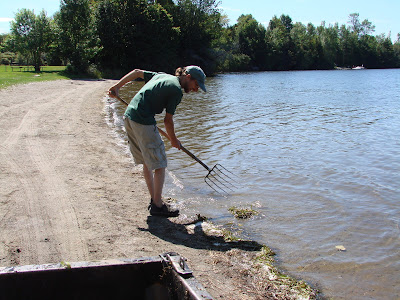Hey, What's In My Water? Swim Water Testing At Vermont State Parks
 |
| Park staff keeps an eye on the beach, cleaning and doing weekly swim water testing |
On a hot day, nothing feels as good as a swim. But before
you jump in that pretty, pristine-seeming lake, do you ever wonder how clean it
is? We all know that appearances can be deceiving, and that even the cleanest
looking lake can harbor bacteria, algae, and other lurking nasties.
This is one reason people enjoy and appreciate visiting our
swimming areas. Vermont State Parks tests swim water at managed areas weekly and
have for over 25 years. “We do it to assure our visitors that we are keeping an
eye on the water in which we recreate,” says Frank Spaulding, Parks Projects
Coordinator who compiles the swim water testing results each week. Occasionally
there are elevated readings and alerts are posted, but, as Spaulding points
out, “consistently, over time, our water is great.”
Every week, 38 different managed swim areas at state park
beaches are tested for e-coli., an indicator bacteria. E-coli may not cause
sickness itself, [but] its’ presence could reflect the possible presence of
other sickness causing organisms. In other words, it’s just a screening test.
Swimming in water with an elevated result is no guarantee that someone will get
sick, or not get sick. It’s also important to keep in mind that the amount of
water tested is small- 4oz., or about half a cup.
After the water is sampled, results go off to certified labs
and are usually returned within a day or two. Results are posted online, and
usually results for all parks are in by the end of the week, in time for the
weekend. View the latest swim water results here.
The most common (and understandable) worry relating to swim-water
testing is about these higher-than-normal test results. And, if there is an elevated
reading at a specific park, “we want everyone to understand that water quality
testing is best looked at over time,” says Spaulding. After an elevated result,
the water is tested again, and results come back after about 24 hours. Almost
always, when staff retests, results have come back to acceptable levels. If you
have questions about testing or results at a specific park, call the park
directly for the latest information, or our central office at 1-888-409-7579.
The other issue on many people’s minds is cyanobacteria
(commonly called blue-green algae), which occurs in certain bodies of fresh water,
and is associated with lakes like Champlain and Carmi.
Cyanobacteria can naturally occur in lakes and ponds. Under
certain conditions large agglomerations can form, called blooms. Blooms can
produce toxins that can cause skin irritation and other health complaints, but
it’s impossible to tell by just looking! Blooms are more common warmer, shallow
water, and tend to appear as the summer wears on. A blue-green algae bloom is
very noticeable and certainly not aesthetically pleasing.
Guidelines to follow: Avoid direct contact with the water in
the area if you see a bloom, and don’t drink lake water that has not been
treated. The Vermont Department of Health recommends cleaning fish thoroughly
and not eating the organs. For more information on cyanobacteria, its’ health
effects, and monitoring efforts on the lake, visit Lake Champlain Internationals' web page.

.jpg)
.jpg)
Comments
Post a Comment
Feel free to let us know what you think.